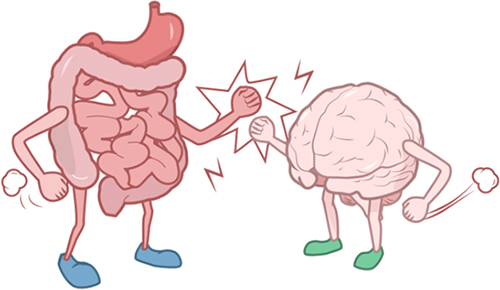Disorders of Gut Brain Interaction (DGBIs): Instructions to Support the Brain and Belly Connection
Important information:
Disorders of gut-brain interaction (DGBI) is a group of conditions where the brain and belly do not communicate appropriately. The brain and belly send signals back and forth, especially when the brain senses stress, danger, or illness. These signals may make the heartbeat faster or the belly feel like butterflies. In most people, once the stress, danger, or illness is gone, the brain calms the body. However, for kids with DGBIs, their body continues to show physical symptoms even when the stress, danger, or illness is gone. Although the brain may not consider something dangerous or stressful, the body can still react with physical symptoms.
 |
| Belly and brain not getting along |
Kids with DGBIs may be diagnosed with visceral hypersensitivity, somatic symptom disorder, chronic or functional abdominal pain, chronic nausea, chronic vomiting, impaired motility, or irritable bowel syndrome. They might attend multiple appointments and undergo tests, procedures, and treatments without feeling better. Many times, they encounter people who don’t understand or believe their symptoms.
Certain factors can make DGBI symptoms worse, including:
-
Poor nutrition or certain foods
-
Dehydration (not drinking enough water)
-
Poor sleep habits
-
Lack of physical activity (laying around, not moving enough)
-
Stress, worry, or other intense emotions (sometimes even happy ones)
These symptoms can disrupt everyday life, including school, friendships, sleep, hobbies, and other daily activities.
Patient instructions: Focus on daily functioning
Your care plan is designed to help you return to your daily routine, even when symptoms are present. Over time, practicing healthy habits can reduce symptoms and improve how you feel.
Follow these SMART habits, even when there are no symptoms:
Sleep
-
Go to bed and wake up at the same time every day.
-
Aim for 8 to 10 hours of sleep each night.
-
Avoid naps during the day.
-
Turn off electronics 30 to 60 minutes before bedtime.
Meals and fluids:
Activity:
Reduce stress:
-
Stress can be physical, environmental, mental, or emotional. Practice the coping strategies listed below.
-
Find activities that help you relax, such as mindfulness or listening to music.
Thinking strategies:
-
Try not to worry or constantly think about your symptoms, as doing so can make them worse.
-
Focus on things you can control, such as your coping strategies.
Nutrition: Strengthen your Belly
Eating might be uncomfortable at first because of nausea, pain, or bloating. However, feeding your body the right nutrition helps rebuild the nerve pathways between your belly and brain. With time, your symptoms will improve. Think of it like touching your toes:
Coping strategies: Strengthen your brain
Use these techniques to feel more in control of your symptoms in the moment:
-
Distract yourself: listen to music, take a shower, do arts and crafts, or talk about something you enjoy.
-
Take slow, deep breaths.
-
Use a stress ball.
-
Tighten and relax different muscles in your body.
-
Write in a journal.
-
Picture a relaxing place.
-
Use grounding exercises, like naming things you see, hear, or feel.
-
Think of something that went well or turned out okay in the past.
-
Talk to someone you trust.
-
Have a snack or drink—try peppermint or ginger candy, tea, water, or a popsicle.
-
Consider aromatherapy, like lavender or peppermint, after talking to your healthcare provider.
Parent support
Parents can help by focusing less on symptoms:
-
Avoid asking about symptoms unless your child brings them up. Trust that your child will come to you for help if needed.
-
When your child complains of symptoms, acknowledge your child’s feelings, then gently redirect their attention to something else.
-
Encourage active coping strategies from the list above.
Remember: Healing takes time
Keep in mind that it takes time for the symptoms to go away. Your child’s symptoms will continue to improve over time when sticking to the care plan. Our care team is here to provide support to help your child improve function and feel in control again.
Encourage your child to take responsibility: “I can do this!”
This treatment is designed to empower your child to manage their own symptoms. Your child’s care team will work with them to increase their independence and coping skills. Kids often feel out of control or controlled by their symptoms. By increasing their responsibility for their own treatment, kids can control their symptoms.
Care team
Your child’s care team includes many specialists working together to support their health and well-being. The medical team—attending physicians, fellows, residents, nurse practitioners (NPs), and physician assistants (PAs)—focuses on diagnosis and treatment.
Psychologists, licensed clinical social workers, behavior analysts, and psychiatrists teach ways to cope with symptoms and help kids get back to the important and fun parts of life. Psychotherapy also helps your child identify and deal with stress. Psychiatrists may recommend medicine to help address mood or anxiety.
Nurses provide care and monitor progress, while social workers connect families to resources. Child life specialists offer education, play, and coping support. Integrative health clinicians use techniques like mindfulness, acupuncture, and massage to ease symptoms. Other team members may include safety observers, creative arts therapists, and pet therapy dogs for comfort.
Reviewed February 2025 by Jennifer Webster, DO